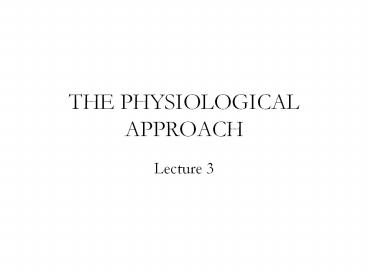THE PHYSIOLOGICAL APPROACH PowerPoint PPT Presentation
1 / 37
Title: THE PHYSIOLOGICAL APPROACH
1
THE PHYSIOLOGICAL APPROACH
- Lecture 3
2
Early history Parallels with technology
- Aristotle
3
Early history Parallels with technology
- Aristotle
- Galen
4
Early history Parallels with technology
- Aristotle
- Galen
- Descartes
5
Early history Parallels with technology
- Aristotle
- Galen
- Descartes
- Mueller
6
Early history Parallels with technology
- Aristotle
- Galen
- Descartes
- Mueller
7
Neurons Electrical Signals
- Johannes Mueller (1842)
- Doctrine of specific nerve energies perceptions
depend on nerve energies reaching the brain and
that the specific quality we experience depends
on which nerves are stimulated
8
The neuron
9
The neuron
Flow of information
10
Recording electrical signals in neurons
11
Recording electrical signals in neurons
12
Recording electrical signals in neurons
13
Recording electrical signals in neurons
14
Recording electrical signals in neurons
15
The resting membrane potential
Na
K
Na
Na
OUTSIDE
Na
Na
K
K
Na
INSIDE
K
K
K
K
Na
Na
OUTSIDE
Na
Na
K
Na
16
The resting membrane potential
Na
K
Na
Na
OUTSIDE
Na
Na
K
K
Na
INSIDE
K
K
K
K
Na
Na
Na
OUTSIDE
Na
K
Na
17
What accounts for activity states?
- Electrostatic force
- Chemical diffusion
- Selectively permeable membranes
18
Electrostatic force Chemical diffusion
19
Selectively permeable membranes
20
The action potential defined
- Action potential brief propagated changes in
neuronal polarization that travel rapidly along
the axon - Depolarization decreased negativity inside the
neuron - Threshold a stimulus intensity just adequate to
trigger an action potential - All-or-none property changing stimulus intensity
does not affect action potential size but does
affect rate of firing
21
The action potential
Na
K
Na
Na
OUTSIDE
Na
Na
K
K
Na
INSIDE
K
K
K
K
Resting membrane potential at potassium
equilibrium (-70mV)
22
The action potential
K
Na
OUTSIDE
Na
Na
K
K
Na
Na
Na
INSIDE
K
Na
K
Na
K
K
40
Sodium flows into the axon Depolarizes to -40 mV,
or threshold Action potential results
- 40
23
The action potential
K
K
K
OUTSIDE
K
K
Na
Na
K
Na
Na
INSIDE
K
Na
Na
Na channels inactivate (absolute refractory
period) completely unresponsive to a second
stimulus Potassium flows out of the axon
24
The action potential
K
K
K
K
K
OUTSIDE
K
Na
Na
Na
Na
INSIDE
K
Na
Na
Potassium continues to flows out of the axon
(relative refractory period)
25
The action potential
Na
K
Na
Na
OUTSIDE
Na
Na
K
K
Na
INSIDE
K
K
K
K
Resting membrane potential back at potassium
equilibrium (-70 mV)
26
(No Transcript)
27
The synapse
28
Chemical electrical events at the synapse
Presynaptic terminal
Postsynaptic spine
29
Excitatory inhibitory input affect firing rate
excitatory input
inhibitory input
30
Excitatory inhibitory input affect firing rate
excitatory input
inhibitory input
31
Excitatory inhibitory input affect firing rate
excitatory input
inhibitory input
32
Excitatory inhibitory input affect firing rate
excitatory input
inhibitory input
33
(No Transcript)
34
Basic Structure of the Brain
35
Localization of function in the brain
36
Localization of function in the brain Franz
Joseph Gall (1796)
37
(No Transcript)

